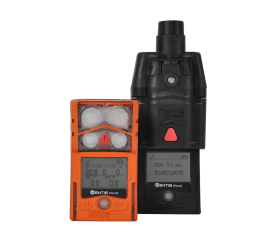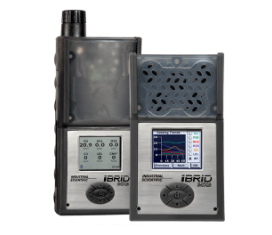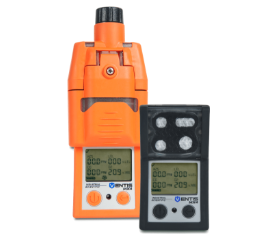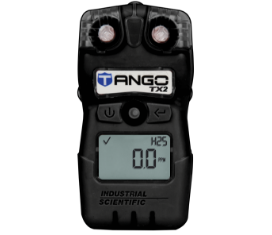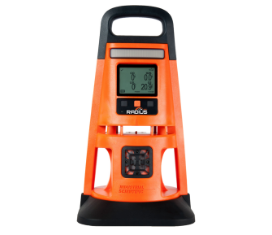Multi-Gas Detectors
Explore Industrial Scientific’s premium selection of Multi-Gas Detectors, designed to detect anywhere from two to seven gases simultaneously. Whether for personal use or area monitoring, our detectors provide reliable solutions to safeguard workers from hazardous gas exposure. From compact portable models to robust area monitors, our advanced devices combine durability, precision, and cutting-edge technology to ensure safety in every environment.
-
Multi-Gas Monitor
Ventis Pro5
Detect up to five gases and connect teams with alarm sharing and remote live monitoring. A man-down alarm, panic button, and custom on-screen messages make it easy to communicate in an emergency.
View the Ventis Pro5 -
Multi-Gas Monitor
MX6 iBrid
Detect up to six gases with hundreds of possible sensor combinations and an internal motorized pump. The MX6 iBrid multi-gas meter adapts to provide advanced gas detection for sampling and permitting tasks.
View the MX6 iBrid -
Multi-Gas Monitor
Ventis MX4
Detect up to four gases with an ultra-portable, rugged multi-gas meter. Eliminate the need for extra monitors and seamlessly transition from personal monitoring to confined space sampling with a slide-on pump.
View the Ventis MX4 -
Multi-Gas Monitor
Tango TX2
Detect two gases with individual sensors to increase alarm accuracy, reduce unnecessary shutdowns, and improve incident data quality. A two-year run time for this multi-gas meter eliminates the need for charging infrastructure.
View the Tango TX2 -
Area Monitor
Radius BZ1
Loud alarms, bold LED lights, and customizable action messages cut through even the busiest work areas. Local and remote monitoring means that both teams on-site and safety managers off-site know how to respond to hazards.
View the Radius BZ1
Frequently Asked Questions
What is a multi-gas meter?
A multi-gas monitor is a device used to detect and measure the presence of multiple gases in the air simultaneously. These monitors are commonly used in a variety of industries to identify potentially hazardous gases, such as combustible or toxic gases, and to alert workers of their presence.
Why should you use a multi-gas detector?
Multi-gas meters are a key part of protecting worker safety, regulation compliance, early detection of gas leaks, and improving situational awareness. Multi-gas meters provide a complete view of your work environment to help you detect leaks before they become dangerous or potentially catastrophic.
The information you gain from multi-gas meters is critical for ensuring worker safety because it helps you identify potential gas hazards and alert workers to prevent accidents and health risks associated with gas exposure. Using a multi-gas meter can also help your company avoid fines and legal liabilities associated with non-compliance.
Overall, using a multi-gas meter is a critical component of workplace safety and can help organizations ensure compliance with regulations, prevent accidents, and protect worker health and safety.
What gases will a multi-gas meter detect?
Our multi-gas meters can detect a wide range of toxic and combustible gases and have flexible configurations to meet your specific safety needs. The sensors we offer include ammonia (NH3), carbon dioxide (CO2), carbon monoxide (CO), chlorine (Cl2), chlorine dioxide (ClO2), hydrogen (H2), hydrogen chloride (HCl), hydrogen cyanide (HCN), hydrogen sulfide (H2S), methane (CH4), nitric oxide (NO), nitrogen dioxide (NO2), oxygen (O2), phosphine (PH3), sulfur dioxide (SO2), and volatile organic compounds (VOCs).
How does a multi-gas meter work?
The most common types of sensors used in multi-gas meters are electrochemical sensors and catalytic sensors. Electrochemical sensors work by triggering an electrochemical reaction when exposed to the target gas. This reaction generates a small electric signal that is detected by the meter and used to determine the gas concentration. Catalytic sensors, on the other hand, use a platinum-coated wire that oxidizes when exposed to combustible gases. This oxidation generates heat, which is detected by the meter and used to determine the gas concentration.
Once the sensors detect the presence of gas, the multi-gas meter will issue an alarm when the gas concentration surpasses a certain threshold, usually the permissible LEL (lower explosive limit). The alarm may be audible or visible.
How many gases can be detected by one monitor?
The number of gases that can be detected by one monitor depends on the specific model and type of gas detector you are using. Industrial Scientific offers a range of multi-gas monitors that can detect up to 7 gases simultaneously.
Depending on a site's needs, these multi-gas monitors come in a wide range of applications: personal monitors, pumped monitors, and area monitors.
Which multi-gas monitors can be used in confined space entry?
The Ventis® MX4, Ventis® Pro5 , and MX6 iBrid® are all great options for confined space entry work.
